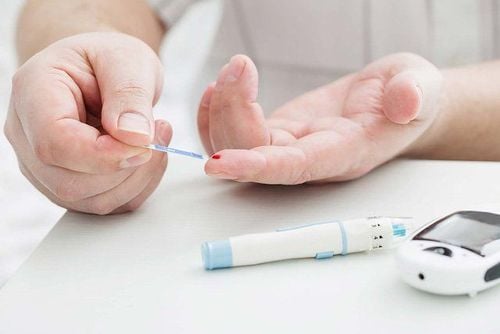This is an automatically translated article.
The article is professionally consulted by Master, Doctor Nguyen Thi Ngoc - General Internal Medicine - Endocrinology - Department of Examination & Internal Medicine - Vinmec Central Park International General Hospital. Doctor has more than 10 years of studying, researching and working in the field of endocrinology.With diabetes, the body cannot get sugar from the blood into the cells, leading to high blood sugar. Glucose, which is the form of sugar commonly found in the blood, is one of the body's main sources of energy. The lack of insulin or insulin resistance causes sugar to build up in the blood leading to many health problems.
1. Definition of diabetes
Diabetes mellitus is a heterogeneous metabolic disorder characterized by hyperglycaemia due to defects in insulin secretion, insulin action, or both.Chronic elevation of glucose for a long time causes disturbances in carbohydrate, protein and lipid metabolism, causing damage in many different organs, especially in the heart and blood vessels, kidneys, eyes, nerves.
2. How many types of diabetes are there?
The classification of diabetes includes:Type 1 diabetes (due to destruction of pancreatic beta cells, leading to absolute insulin deficiency). Type 2 diabetes (due to impaired pancreatic beta cell function progressing against the background of insulin resistance). Gestational diabetes (diabetes diagnosed in the second or third trimester of pregnancy and without evidence of type 1 or type 2 diabetes before). Diabetes caused by other causes, such as: Neonatal diabetes or diabetes caused by the use of drugs and chemicals such as glucocorticoid use, HIV/AIDS treatment or after tissue transplantation...

Đái tháo đường gồm 3 loại: Đái tháo đường type 1, Đái tháo đường type 2 và Đái tháo đường thai kỳ
3. Compare type 1 and type 2 diabetes
3.1 About the cause 3.1.1.Type 1 diabetes Type 1 diabetes is an autoimmune condition. This means that the person's immune system mistakenly attacks and destroys the beta cells in the pancreas that produce insulin, causing permanent damage. Currently, doctors have not found the exact cause of the body's own attack on the pancreas, which may be genetic and environmental. Lifestyle factors were not associated with the cause of type 1 diabetes.3.1.2 Type 2 Diabetes Type 2 diabetes is caused by insulin resistance, which means the body cannot use insulin effectively. This stimulates the pancreas to produce more insulin until it cannot keep up with the demand. Then, the ability to produce insulin decreases, resulting in high blood sugar.
The exact cause of type 2 diabetes is unknown. Factors may include:
Genetics Lack of exercise Being overweight There can also be other health factors and environmental reasons. >> See more: Features of drugs to treat type 2 diabetes
3.1.3 Gestational diabetes Gestational diabetes is caused by hormones that block insulin produced during pregnancy. This type of diabetes occurs only during pregnancy.
3.1.4 About symptoms General symptoms of diabetes include:
Excessive thirst and hunger Frequent urination Drowsiness or fatigue Dry itchy skin Blurry vision Slow-healing wounds Type 2 diabetes can create dark patches in the folds of skin in the armpits and neck. Because type 2 diabetes often takes longer to diagnose, you may notice symptoms at the time of diagnosis, like pain or numbness in your feet.
Type 1 diabetes usually develops more quickly and can cause symptoms such as weight loss or diabetic ketoacidosis, which can occur when a person has high blood sugar levels. very high blood pressure, but little or no insulin in the body.
Symptoms of both types of diabetes can appear at any age, but type1 generally occurs in children and young adults. Type 2 occurs in people over 45 years of age. But today, many young people are diagnosed with type 2 diabetes due to sedentary lifestyle and weight gain.
3.1.5 Prevalence of diabetes According to the World Diabetes Federation (IDF), in 2015 worldwide there were 415 million people (aged 20-79) with diabetes, equivalent to every 1 in 11 people have diabetes, by 2040 this number will be 642 million, equivalent to 1 in 10 people with diabetes. In addition, along with the increase in inappropriate food consumption, little or no physical activity in children, type 2 diabetes is on the rise in both children, becoming a public health problem. serious copper.
Diabetes causes many dangerous complications, is a leading cause of cardiovascular disease, blindness, kidney failure, and amputation. But one thing is positive, up to 70% of cases of type 2 diabetes can prevent or slow the onset of the disease by following a healthy lifestyle, proper nutrition and increased physical exercise.
According to the results of the STEPwise survey on risk factors for non-communicable diseases conducted by the Ministry of Health in 2015, in the 18-69 age group, the national diabetes rate was 4.1%, pre-diabetes was 3.6%.
4. What are the potential complications?

Đái tháo đường có thể có biến chứng là bệnh mạch máu, dẫn đến đau tim hoặc đột quỵ
Blood vessel disease, leading to heart attack or stroke Eye problems, called retinopathy Skin infections Nerve damage or neurological disease Kidney damage or kidney disease Amputation neurological or vascular disease Type 2 diabetes can increase your risk of developing Alzheimer's disease, especially if your blood sugar is not well controlled. Complications in pregnancy
High blood sugar during pregnancy can be dangerous for mother and baby, increasing the risk of:
High blood pressure Pre-eclampsia Miscarriage or stillbirth Birth defects
5. Treatment of diabetes

Bất kể bạn mắc bệnh tiểu đường loại nào, bạn sẽ cần phải làm việc chặt chẽ với bác sĩ để kiểm soát bệnh
The main goal is to keep blood glucose levels within your target range. Your doctor will tell you what your target range should be. Goals vary from person to person based on the type of diabetes you have, your age, and the complications you have.
If you have gestational diabetes, your blood sugar goals will be lower than those of people with other types of diabetes.
Physical activity is an important part of diabetes management. Ask your doctor how many minutes per week you should spend on aerobic exercise. Diet is also important for good control. You also need to monitor your blood pressure and cholesterol.
5.1 Treatment of type 1 All people with type 1 diabetes must take insulin for life due to permanent damage to the pancreas. Insulin is injected just under the skin. Your doctor will instruct you on how to inject and where to inject. You can also use an insulin pump, which is a wearable device outside your body that can be programmed to release a specific dose of insulin.
Now there is a continuous blood sugar monitor to check your sugar for the day. If necessary, you may also need to take additional medications to control cholesterol, high blood pressure, or other complications.
5.2 Type 2 Treatment Type 2 diabetes is managed with diet and exercise, and can also be treated with a variety of medications to help control blood sugar. The first drug is usually metformin (Glumetza, Glucophage, Fortamet, Riomet). This medicine helps your body use insulin more efficiently. If metformin doesn't work, your doctor may add other medicines or change medicines.
You also need to monitor your blood sugar and may need additional medications to help control blood pressure and cholesterol.
At Vinmec hospital, we always deploy a screening package for diabetes and dyslipidemia to help detect pre-diabetes early, accurately classify diabetes type, develop a nutritional regimen, and monitor the treatment of diabetes. risks and complications caused by diabetes.
Please dial HOTLINE for more information or register for an appointment HERE. Download MyVinmec app to make appointments faster and to manage your bookings easily.
Article referenced source: healthline.com












